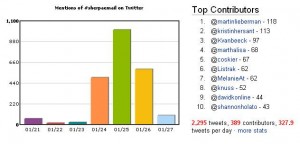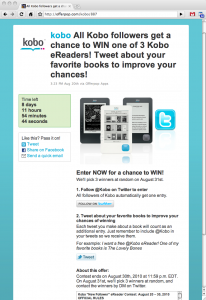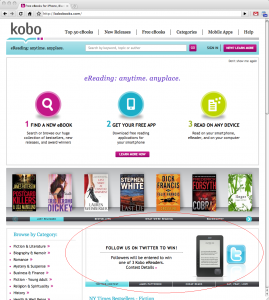So, how’s this for a business model? An “ongoing T-shirt design competition.”
Well, that’s the way Threadless keeps hip people in hip T-shirts. And with a  business model like that, you need A LOT of engagement and interaction with your customers…key marketing buzzwords for 2011.
business model like that, you need A LOT of engagement and interaction with your customers…key marketing buzzwords for 2011.
To get a behind-the-scenes look at how the online T-shirt retailer works its mojo, you can attend the “Growing Email Lists and Engaging Customers with Social Media” how-to panel at Email Summit 2011 in Las Vegas (January 24-26). Liz Ryan, Email Marketing Manager, Threadless, will be one of the panelists.
To give us a quick glimpse into the Threadless marketing machine (or, perhaps, marketing loom), Liz was kind enough to answer the following questions…
Threadless has more than 1.5 million followers on Twitter. What can you possibly be tweeting about that’s so interesting?
Liz Ryan: We wouldn’t have much to say if it weren’t for our awesome community. The majority of our tweets focus on our community-submitted tee shirt designs, voting, and community events. We also of course tweet about any specials on pricing, shipping and new products.
Sometimes we tweet on things going on at HQ, live stream of a band playing in the warehouse, DJ or holiday party. Other times it’s an interview with our founder, Jake Nickell, an event we’re participating in, or a Threadspotting – celebrities in Threadless shirts.
Our marketing team has autonomy over the channels we manage. So there is a flexibility and authenticity to the way we manage social media. We tweet about what we want to tweet about without approvals, executive sign offs and strict calendars.
It’s collaborative in that email, social, public relations and advertising work together to make sure messaging is cohesive, but other than that we have complete control over our channels.
Part of your panel is about “…and Engaging Customers with Social Media.” When we hear about social media, we hear a lot about engagement. But how can marketers move customers beyond just engagement to action?
LR: Give them something to take action on.
As marketers, we’re used to pushing information at consumers. We have to change that dynamic and give them something worth pulling and something worth doing:
- Open dialog – At Threadless, we provide an opportunity to have an open dialog with the Threadless team and other community members and an opportunity to take action. That might mean buying a tee shirt, but we also place a high priority on inspiring our community to submit a design, or to vote on designs, or comment on designs, or blog, or come out to a stop on our tour, or post a photo.
- Incentives – We not only provide information about what’s going on with Threadless, but we give our community incentives to take action on promotions – whether it’s a giveaway on Twitter, trivia on Facebook, or responding to a blog post.
- Don’t micro-manage – We don’t micro-manage our community involvement on comments to each other regarding their work. We give our community the power and voice to be Threadless and they take it from there.
Threadless is a “community-centered online apparel store.” I got that information, by the way, from Wikipedia, which, of course, is also collaborative. Marketers are increasingly looking to leverage community-based models – from creating Super Bowls ads to creating, as you do, T-shirts. And, when you think community, most people naturally think of social media. But is an email list a community as well?
LR: Absolutely, email is the original social media. As email marketers, we struggle with making email a two-way interaction. There have been groups and listserv since email was invented, but how do you scale that to one million plus email subscribers?
It’s important we don’t silo email as a solitary channel. At Threadless, we use email to help guide subscribers to our site with newsletters that highlight our latest designs.
We encourage discussion about the designs, the company and our community through blogs and social media channels. It doesn’t make sense to ask one million subscribers to respond to an email, so it alone is not always a two-way channel, but absolutely we respond to emails if someone does reply to our email.
We also respond to our community’s preferences to not receive all our emails or to get info on new designs through social channels only, or maybe you only want to hear about sales. Great! Email is a channel by which we can serve our community, and through that sell some tee shirts.
Your community of 1.3 million regularly votes on their favorite T-shirts. Why? In other words, in possibly a combination to my two previous questions, what motivates them to act?
LR: We give them the platform by which to act, and they are motivated by each other, the community itself. They’re generally supportive of one another’s efforts and feel the need to give feedback to fellow artists. They also feel emboldened to choose new tees to be printed. Their participation can directly affect which shirts are available to buy.
Since you are essentially crowdsourcing your main products, your T-shirt creators aren’t punching a clock at Threadless HQ, I would imagine you would want to keep a pretty close eye on the competition. After all, they could steal not just some of your best product ideas, but also the very people who created the T-shirt designs. What kind of competitive analysis do you perform?
LR: We keep an eye out on other graphic tee companies, but because our business model is ever evolving, we don’t worry so much about what other companies are doing as much as our focus on giving our community what they want – multiple platforms to display their art while providing outlets to give and receive feedback to each other.
I do however receive emails from other tee-shirt lines. In general I am constantly monitoring retailers’ email programs to see what others in the space are doing in terms of messaging, cadence and any deliverability issues they may have.
My favorite T-shirt on Threadless is…
Haikus are easy
But sometimes they don’t make sense
Refrigerator
What’s yours?
LR: As a zombie culture fan, I love The Horde. As a mom, I’m really into the Threadless Kids! line, especially the new longsleeves. Running Rhino is one of my all time favorite designs.
Related Resources
Social Marketing: Twitter contest boosts followers 43%
Social Media Marketing: How enterprise-level social media managers handle negative sentiment
Improve Your Facebook Profile to Increase Consumer Interaction: 4 Tactics (Members’ Library)
New MarketingSherpa Inbound Marketing Newsletter
Twitter ‘Teaser’ Campaign Supports One-Day Sale: 5 Steps to a 4% Conversion from Tweets (Members’ Library)
Photo by dan taylor

















